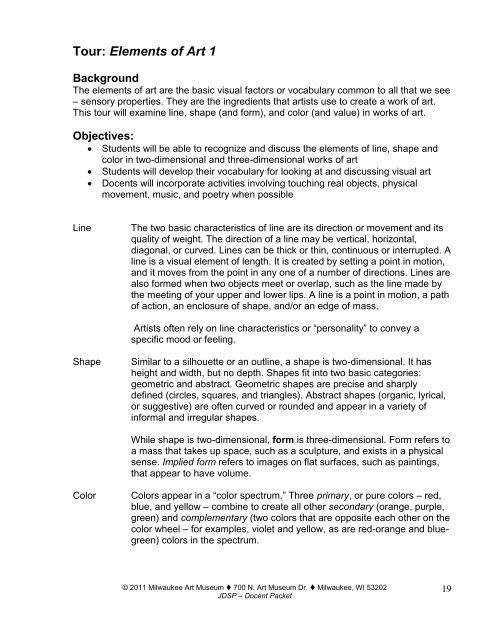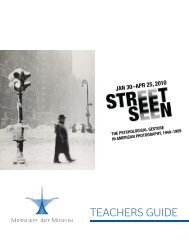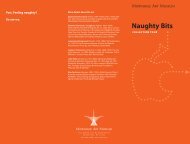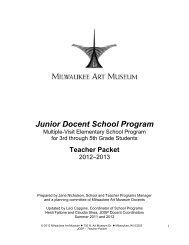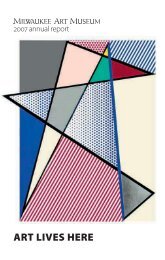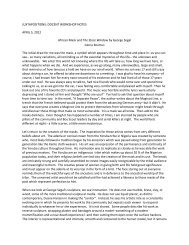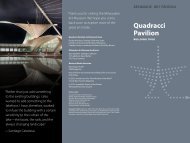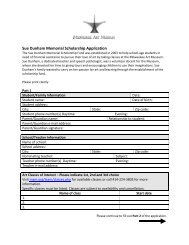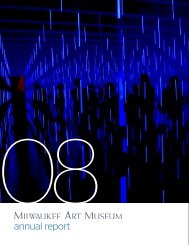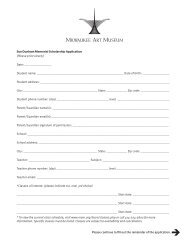Junior Docent School Program - Milwaukee Art Museum
Junior Docent School Program - Milwaukee Art Museum
Junior Docent School Program - Milwaukee Art Museum
Create successful ePaper yourself
Turn your PDF publications into a flip-book with our unique Google optimized e-Paper software.
Tour: Elements of <strong>Art</strong> 1<br />
Background<br />
The elements of art are the basic visual factors or vocabulary common to all that we see<br />
– sensory properties. They are the ingredients that artists use to create a work of art.<br />
This tour will examine line, shape (and form), and color (and value) in works of art.<br />
Objectives:<br />
<br />
<br />
<br />
Students will be able to recognize and discuss the elements of line, shape and<br />
color in two-dimensional and three-dimensional works of art<br />
Students will develop their vocabulary for looking at and discussing visual art<br />
<strong>Docent</strong>s will incorporate activities involving touching real objects, physical<br />
movement, music, and poetry when possible<br />
Line<br />
The two basic characteristics of line are its direction or movement and its<br />
quality of weight. The direction of a line may be vertical, horizontal,<br />
diagonal, or curved. Lines can be thick or thin, continuous or interrupted. A<br />
line is a visual element of length. It is created by setting a point in motion,<br />
and it moves from the point in any one of a number of directions. Lines are<br />
also formed when two objects meet or overlap, such as the line made by<br />
the meeting of your upper and lower lips. A line is a point in motion, a path<br />
of action, an enclosure of shape, and/or an edge of mass.<br />
<strong>Art</strong>ists often rely on line characteristics or “personality” to convey a<br />
specific mood or feeling.<br />
Shape<br />
Similar to a silhouette or an outline, a shape is two-dimensional. It has<br />
height and width, but no depth. Shapes fit into two basic categories:<br />
geometric and abstract. Geometric shapes are precise and sharply<br />
defined (circles, squares, and triangles). Abstract shapes (organic, lyrical,<br />
or suggestive) are often curved or rounded and appear in a variety of<br />
informal and irregular shapes.<br />
While shape is two-dimensional, form is three-dimensional. Form refers to<br />
a mass that takes up space, such as a sculpture, and exists in a physical<br />
sense. Implied form refers to images on flat surfaces, such as paintings,<br />
that appear to have volume.<br />
Color<br />
Colors appear in a “color spectrum.” Three primary, or pure colors – red,<br />
blue, and yellow – combine to create all other secondary (orange, purple,<br />
green) and complementary (two colors that are opposite each other on the<br />
color wheel – for examples, violet and yellow, as are red-orange and bluegreen)<br />
colors in the spectrum.<br />
© 2011 <strong>Milwaukee</strong> <strong>Art</strong> <strong>Museum</strong> 700 N. <strong>Art</strong> <strong>Museum</strong> Dr. <strong>Milwaukee</strong>, WI 53202<br />
JDSP – <strong>Docent</strong> Packet<br />
19


